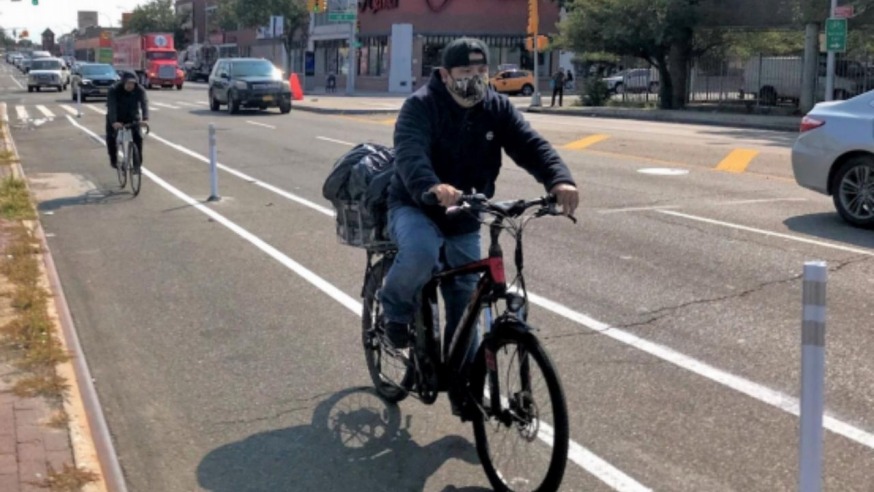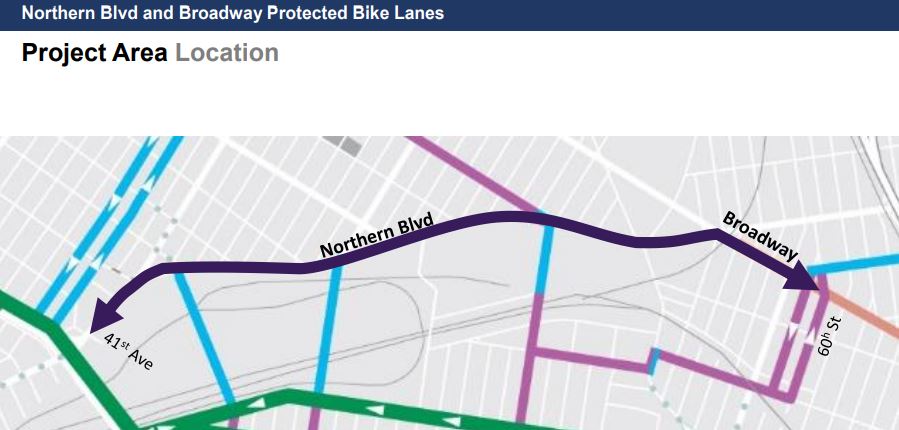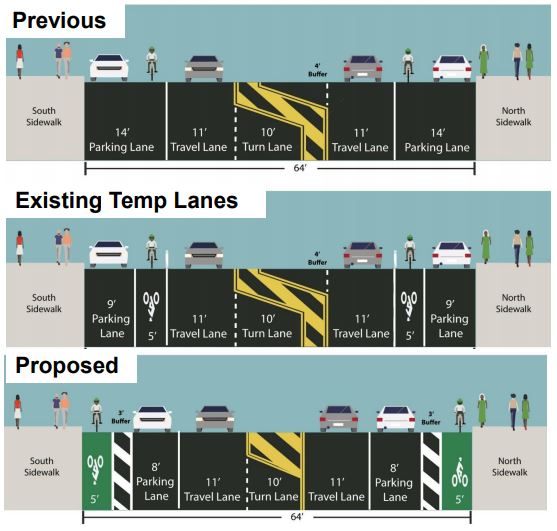
The DOT has released plans to install protected bicycle lanes on Northern Boulevard and Broadway. Above: cyclists riding on a stretch of the Northern Boulevard temporary protected bike lane. The temporary lane is currently separated from motorists by plastic delineators (Photo: DOT).
Feb. 15, 2021 By Michael Dorgan
The Department of Transportation has unveiled plans to install a permanent two-way protected bike lane along Northern Boulevard that would better connect cyclists in Woodside to the Queensboro Bridge.
The plans, which were presented to Community Board 1’s Transportation Committee Wednesday, would see a permanent two-way bike lane stretch from Northern Boulevard and 41st Avenue in Long Island City–to 60th Street and Broadway in Woodside. There would be one bike lane on each side of the thoroughfare.
The DOT said it wants to make the route safer for riders in order to reduce the number of cyclist fatalities throughout the city.
The plans would essentially see the temporary protected bike on Northern Boulevard – that was put down in September – become permanent with some minor upgrades. The DOT would put down green paint along the bike lane and add markings at intersections along the route.
The most significant changes would be along Broadway where the DOT is looking to convert the curbside vehicle parking lanes into protected bike lanes. Like Northern Boulevard, there would be one lane on each side of the road.
At present along Broadway, a temporary protected bike lane runs between the vehicle parking lane and the main vehicle traffic lane. The new plan would essentially switch the protected bike lane with the vehicle parking lane.
The new Broadway layout would result in the loss of 22 vehicle parking spaces.

Northern Blvd. and Broadway Protected Bike Lane plans (Department of Transportation)

Proposed protected bike lane design for Northern Blvd. (Department of Transportation)

Proposed protected bike lane design for Broadway (Department of Transportation)
The DOT is also proposing to put down turn treatment road markings at busy intersections along Broadway. The markings would slow right-turning vehicles in order to reduce the risk of collisions with cyclists traveling in the same direction. The markings would also enhance pedestrian safety by shortening crossing distances.
The plan, which was also presented to Queens Community Board 2 Transportation Committee on Feb. 2, forms part of a city-wide initiative that was launched in the summer of 2019 that called for an additional 80 miles of protected bike lanes to be completed by the end of 2021.
The city said that between 2007 and 2017 there was a 15 percent drop in all crashes with injuries where protected bike lanes were installed.
However, some CB1 committee members said that the DOT’s proposal doesn’t go far enough in keeping cyclists safe–since the only physical barrier separating cars from bicycles under the plan are spaced out plastic delineators.
Some board members– as well as bicycle advocates– are demanding that jersey barriers be put down to separate the protected bicycle lane from motorists.
Juan Restrepo, Queens organizer for Transportation Alternatives, said that flexible delineators are merely guidance devices. He said motorists in New York City often encroach onto bike lanes and can end up crashing into cyclists.
“That is a very scary situation for riders,” he said.
He said that Transportation Alternatives favors jersey barriers but the city can still make better use of the flexible delineators if the gaps between them are minimized. He said when they are lined up closely together they deter motorists from encroaching into bike lanes.
Florence Koulouris, Community Board 1 manager, said that committee members were pushing hard for jersey barriers, seeking greater protection for bicyclists.
“Board members were advocating for jersey barriers but the DOT seemed to be leaning toward putting down flexible delineators,” Koulouris said.
The DOT says that it is easier to maintain the protected bicycle lanes when there are plastic delineators. The agency says that jersey barriers restrict the accessibility of sanitation vehicles to clean them.
“We will look into stronger protection, with the constraint being that we need to see that the lane is both plowable and sweepable by the Dept. of Sanitation, or that an alternative cleaning plan is found,” a DOT spokesperson told the Queens Post.
